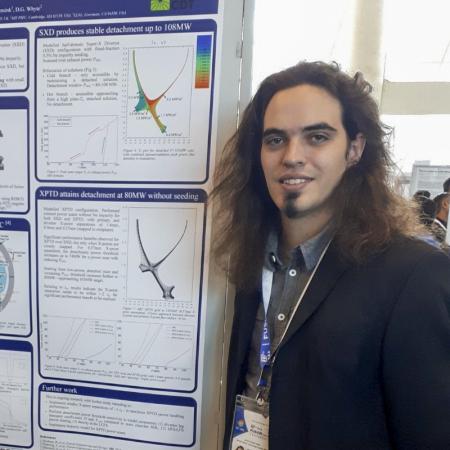
Mike Wigram
Mike Wigram
Plasma Science and Fusion Center
Monday, October 5, 2020
2:00pm
Remote
Abstract: Managing the steady-state power loading onto the divertor target plates remains a major challenge facing the realisation of tokamak fusion energy, that will be crucial for the success of the next generation of high-power reactor level devices. Fusion reactors will have exhaust powers of 100s of MW, which in some cases will be concentrated into a scrape-off-layer (SOL) heat flux width of just a few mm (or less), presenting a daunting challenge for power exhaust management. This talk will present the results of my PhD thesis work, which tackled two topics within this wide research area: assessing the performance of advanced divertor geometries in the ARC reactor concept, and studying the impact of `nonlocal' thermal transport on modelling predictions for the ITER tokamak SOL.
Advanced divertor configurations have been proposed as potential solutions to the divertor heat flux problem, but the question remains as to how such divertors may perform in reactor settings. Numerical simulations were performed using the UEDGE code to study two such advanced divertor concepts in the context of the ARC reactor design, focussing on long-legged divertor geometries of the Super-X divertor (SXD) and X-point target divertor (XPTD) configurations. Operational windows for full divertor detachment are determined in both configurations, and the power exhaust performance is analysed and compared.
Accurate modelling of the thermal transport in the SOL is of great importance both for predicting the power loading on plasma facing components and in assessing the potential success of divertor designs. In the presence of steep temperature gradients, classical ‘local’ transport theory – on which the majority of current large-scale SOL codes are built – breaks down, and the thermal transport becomes ‘nonlocal’, depending on conditions in distant regions of the plasma. An advanced nonlocal thermal transport model was implemented into the 1D complex SOL code “SD1D” to create “SD1D-nonlocal”, to attempt to more accurately capture kinetic corrections to the heat flux calculations, and is applied to study typical ITER steady-state conditions. Strong discrepancies are observed for the code predictions between the conventional and nonlocal heat flux models under low collisionality conditions. Using SOL collisionality as a metric for nonlocality, results are extended to suggest that nonlocal effects will be significant for future devices such as DEMO and ARC as well.
Bio: Mike Wigram is a Postdoctoral Associate at the PSFC, having started in February 2020, working on modelling of advanced divertors geometries for the upcoming Italian DTT device, with a focus on long-legged configurations, as part of a collaboration with CFS, Eni and ENEA. Mike completed his PhD in January 2020 at the University of York as part of the UK Fusion Centre for Doctoral Training (Fusion CDT), studying simulation and modelling of thermal transport in the SOL for high-power fusion devices.
MIT NW17-218 is inviting you to a scheduled Zoom meeting.
Topic: PSFC Seminar: M. Wigram
Time: Oct 1, 2020 01:30 PM Eastern Time (US and Canada)
Join Zoom Meeting
https://mit-psfc.zoom.us/j/6174522043?pwd=NHN3ZHFURUJLM0VkQnprOVkyaVhNUT09
Meeting ID: 617 452 2043
Passcode: Fusion